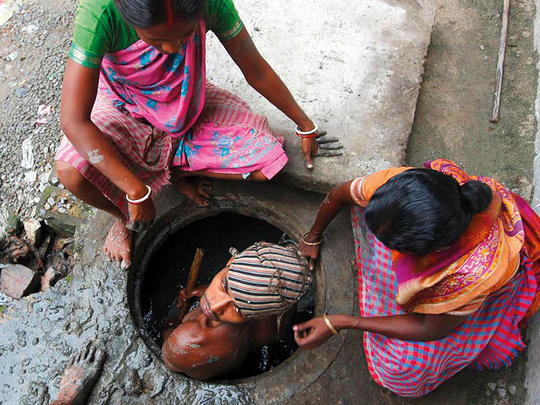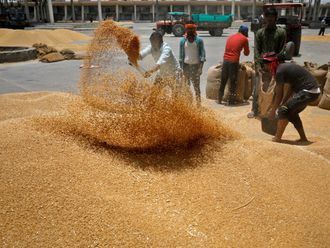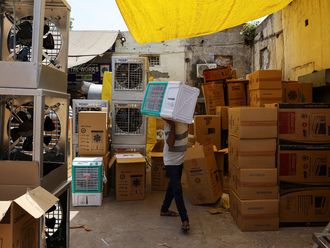
New Delhi: Three storeys beneath the ground, Pradeep Jangra struggled to pull his childhood friend out of a deep sewage treatment tank.
His friend, Vishal Pasi, was disoriented and covered in muck from head to toe. “I can’t breathe,” Pasi told him haltingly.
Within hours, Pasi was dead, along with four other young men who also entered the sewage tanks of a posh new apartment complex in India’s capital on Sunday. Police say the five workers asphyxiated and drowned.
Their deaths were not an anomaly but part of a disturbing pattern.
In a little over a year, more than 20 workers have died in sewers and treatment tanks in New Delhi, a city of growing wealth and rising ambition.
Across India, the figures are higher; activists have documented more than 200 such deaths since the start of 2017, a figure they say significantly understates the problem.
Sanitation drive
The fatalities coincide with a massive effort to improve sanitation in India. Prime Minister Narendra Modi’s Swachh Bharat (‘Clean India’) campaign includes a nationwide toilet-building drive and competitions among cities to eliminate trash from their streets.
At the same time, little has changed for the workers who do the hazardous and stigmatised job of dealing with human waste. Cleaning sewers and removing blockages is still largely done by hand, despite a 2013 law prohibiting the practice. Safety equipment is mandated by law, but hardly ever used. Violators are not convicted.
The perils faced by these workers are emblematic of a broader challenge in a country that has experienced rapid economic growth over the past decade, lifting millions out of poverty but exacerbating income inequality.
Sunday’s deaths occurred at DLF Capital Greens, a gated community catering to the aspirations of India’s wealthy. Nearby are BMW, Jaguar and Land Rover dealerships. Across the road from the cream-coloured towers are several ornate banquet halls, including one called the Golden Royale featuring a glittering three-story chandelier.
Earlier this year, three people died after inhaling poisonous gases at the sewage treatment tank of a five-star hotel in the toniest area of New Delhi, steps from a fashionable market frequented by foreigners. Last August, two brothers suffocated while cleaning a sewage tank at a shopping mall in the eastern part of the city.
Struggle to eradicate manual scavenging
India’s long struggle to eradicate manual scavenging — the practice of dealing with human waste by hand, whether in dry latrines or in sewers — is complicated by the enduring influence of the caste system. Such jobs are still overwhelmingly performed by Dalits, those previously called “untouchables.”
Caste-based practices “haunt India’s efforts to cope effectively with the waste of a vast, urbanising population,” academics Assa Doron and Robin Jeffrey wrote in a new book released this year. The practices hinder cooperation and foster feelings “that removing noxious materials is someone else’s job — even by virtue of birth.”
India has the technology to launch satellites into space and missions to the moon, noted Bezwada Wilson, a prominent activist who has spent years trying to eradicate manual scavenging. “But we don’t have technology to clear the sewer lines and the septic tanks just 10 or 20 feet down,” he said.
Wilson leads an organisation called the Safai Karamchari Andolan, or the Sanitation Workers Movement. He called on Modi to announce immediately a plan to prevent the deaths.
“Five people died, and you are not responding with even one word,” Wilson said, addressing the prime minister.
Manual vs mechanised cleaning
Cleaning sewers and septic tanks is usually done by men wearing minimal clothing who enter the muck with rudimentary tools such as metal scrapers and sticks. Some Indian cities have begun to mechanise the process, using trucks equipped with rods and water sprayers, in smaller-scale variations of sewer-cleaning machinery used in developed countries. New Delhi plans to introduce 200 such trucks next month.
When human intervention is necessary, “there should be certain trained people who do these life-threatening tasks” outfitted with an array of protective gear, said Suresh Kumar Rohilla of the Centre for Science and Environment in New Delhi. “Everything requires cost, and people cut corners,” he said.
Jangra said he received no training for his job at the small sewage treatment plant, consisting of at least two tanks, below DLF Capital Greens. Two months ago, the tanks began to stink — so much so that one resident said he could smell them in his apartment on the 19th floor. On Sunday afternoon, a supervisor ordered a group of young workers into the tanks, despite their protests, to resolve an issue with the waste flow, Jangra said. They wore no safety gear.
Jangra, 21, and his friend Pasi, 20, earned about $165 (Dh600) a month. Unnati Engineering & Contractors, a company subcontracted to run the sewage plant, employed them. Unnati received the contract from the Indian arm of JLL, a global real estate giant headquartered in Chicago and formerly known as Jones Lang LaSalle. JLL, in turn, was employed to “run the whole property for us,” said a spokesman for DLF (Delhi Land and Finance), one of India’s largest real estate developers.
JLL issued a statement on Wednesday saying it was “shocked and deeply saddened” by the incident and was cooperating with the relevant authorities as well as launching its own review. Unnati did not respond to requests for comment. A supervisor employed by JLL has been arrested, Deputy Commissioner of Police Monika Bhardwaj said, adding that more arrests will follow.
Government officials attempted to shift blame for the deaths. In an interview outside the building earlier this week, Adesh Kumar Gupta, the Mayor of North Delhi, said the city sewer authority and the Delhi state government were responsible for supervising the treatment plant. The vice-chairman of the sewer authority told local media that such private plants were outside its control.
Jangra and Pasi lived in a broken-down neighbourhood of narrow lanes in an area called Nangloi, a world away from the elaborate gates and landscaped lawns of the Capital Greens complex. On a recent evening, a battered tarpaulin had been strung across the lane to shield mourners sitting on plastic chairs from the sun and rain.
Pasi was the family’s main source of income. His father, an electrician, had stopped working due to complications from diabetes, while his brother Angad Pasi, 23, was pursuing a bachelor’s degree in the hopes of landing a government job.
Angad Pasi recalled how he and his brother dreamed of starting a business together, one that would allow them to build a “proper” house that did not leak when it rained. The family was desperate for help he said, covering his eyes with his hands to hide his tears, but they had heard nothing from either DLF or JLL.
“Five people died. This is not a small thing,” he said. “This is not an accident. This is murder.”












